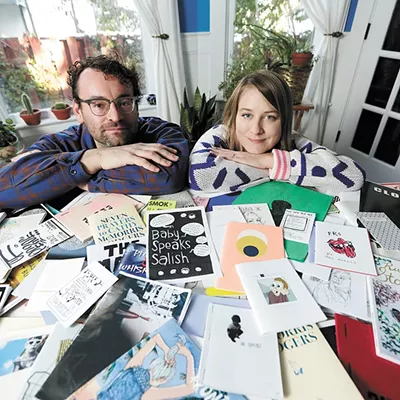Mimi Marinucci might not be where she is today had it not been for the copy machine. A teenager in the 1980s, she and many others took advantage of the sudden proliferation of new-fangled Xerox machines to express themselves in ways they never could before. Soon, handmade underground publications called “zines” started to pierce the cultural conscious, becoming the go-to medium for punk rock and rebellious counterculture. Their doit-yourself designs littered the bedrooms and bookshelves of anarchists and hippies alike.
“It was access to printing … That may seem like something that’s not a huge deal now but at the time, I remember it really was,” Marinucci, a zine writer, says. It was as if the Gutenberg press had been re-born and revitalized in the hands of angsty teenagers who had something to say. With copy machines, they could more easily spread their thoughts and words.
Even today, in the age of massive, instant communication online, zines’ fiercely independent, DIY mentality is still alive and well. Nowhere is that more evident than on the third floor of the Community Building, where two bookshelves containing more than 1,500 zines sit in the hallway outside the offices of KYRS Thin Air community radio.
Some of them larger than a notebook, others no bigger than a Post-It note, the zines in the Bird’s Nest Zine Library are categorized by topic. Anarchy. Feminism. Animal rights. Queer theory. There are titles like Emily’s Heart and Pink Tea, featuring whimsical doodles of cats, sailboats and starfish.
Some are hand-written — others cling to the romantic nostalgia of a square-ish typewriter font.
In one, a cartoon giraffe has been photocopied, cut out, then pasted onto the page. Inside a thought bubble, this strangely wise character talks about the underwhelming act of losing one’s virginity. The pages are delicate and warped from wet ink. And although this booklet’s covers are made of an old pudding box — and its spine of blue yarn — its words are powerful.
Lindsae Williams-Sindalu and Allynn Carpenter founded the library in the summer of 2010 because they loved how the medium democratized communication, giving everyone a platform for expression.
“I was joking with someone that this library has something for everyone,” Williams-Sindalu says. “From bored hipsters to overzealous anarchists.”
The collection, which is far from mainstream, collects more than 300 zine titles from across the United States, including 30 titles from Spokane.
Williams-Sindalu says the library could — and will — expand. “The main hurdle is just having more room to grow because it does get crowded when a couple people are in here reading,” she says.
The volunteers are looking for a larger, rent-free space to host the library, zine-making workshops, readings, meetings and workshops, and house other subculture publications.
“Zines provide a voice for people who maybe otherwise wouldn’t be able to make their opinions known and available,” says Williams-Sindalu. “As a library, our main goal is to make people more aware that we are here as a resource to the general public.”
The two slowly pieced together the library from their personal collections and private donations. Today, zines from the early 1990s are available for check-out.
“Zines aren’t just words on a page,” says Williams-Sindalu. “These zines are little pieces of art in the way that they are presented. And without these copies, someone’s artwork, someone’s writing and a readers experience of coming into contact with that, would be lost.”
This physical contact, the in-hand experience with both words and artwork, is what sets zines apart from blogs and other forms of online communication.
“Having a physical copy of something that someone has physically created and painstakingly collaged is an experience you can’t replicate online,” Williams- Sindalu says.
Marinucci, the author of a feminist zine, Wave 2.5, agrees: “I want my zines to be something physical, an artifact, you know? A little tiny piece of art.”
Today, Marinucci is a professor of philosophy and women’s studies at Eastern Washington University. She started her zine in the early 2000s as a forum to write, create and produce outside of the stringent guidelines of academia.
“I think I just like that spirit of rebellious independence,” she says.
Marinucci says making her zine, in which she explores her own wavering between second-wave and third-wave feminist doctrines and theories, is a labor. She designs it on a computer and fills it with social commentary, queer theory, crossword puzzles, cartoons and recipes.
Like most zinesters, Marinucci haphazardly publishes, prints and distributes her own material. She typically prints 200 copies and gives them to everyone she knows. Next, she does this “stealth thing” where she secretly leaves copies in restrooms, coffee shops and conference halls.
“I like to think of it as a little present that I’m giving to the world,” she says. “And the benefits of controlling the publishing process and maintaining unrestricted expression are priceless.”
The Bird’s Nest Zine Library • 35 W. Main Ave. • Open Wed and Fri, 1-5 pm • 496-4386

















